Paper Menu >>
Journal Menu >>
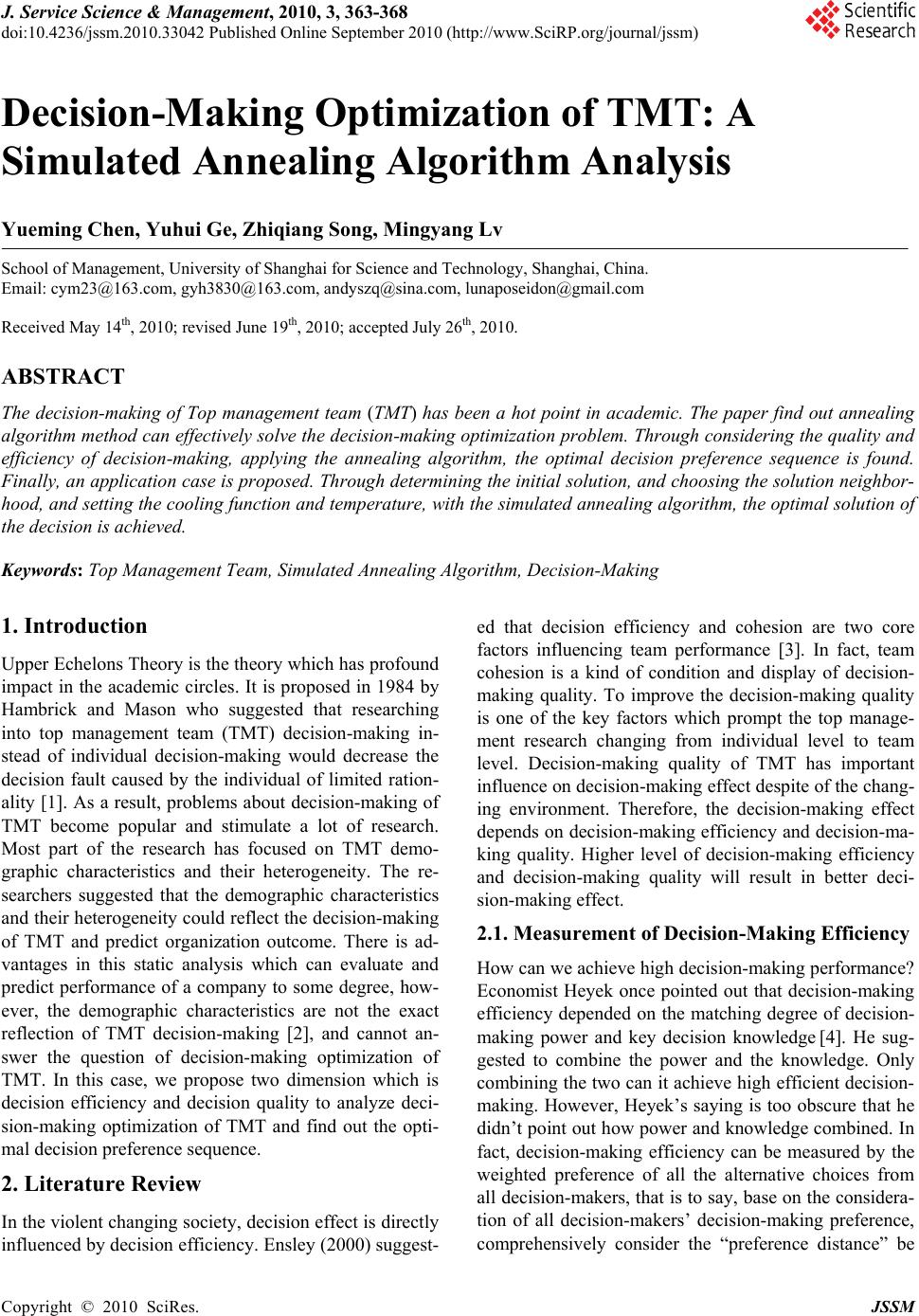 J. Service Science & Management, 2010, 3, 363-368 doi:10.4236/jssm.2010.33042 Published Online September 2010 (http://www.SciRP.org/journal/jssm) Copyright © 2010 SciRes. JSSM 363 Decision-Making Optimization of TMT: A Simulated Annealing Algorithm Analysis Yueming Chen, Yuhui Ge, Zhiqiang Song, Mingyang Lv School of Management, University of Shanghai for Science and Technology, Shanghai, China. Email: cym23@163.com, gyh3830@163.com, andyszq@sina.com, lunaposeidon@gmail.com Received May 14th, 2010; revised June 19th, 2010; accepted July 26th, 2010. ABSTRACT The decision-making of Top management team (TMT) has been a hot point in academic. The paper find out annealing algorithm method can effectively solve the decision-making optimization problem. Through considering the quality and efficiency of decision-making, applying the annealing algorithm, the optimal decision preference sequence is found. Finally, an application case is proposed. Through determining the initial solution, and choosing the solution neighbor- hood, and setting the cooling function and temperature, with the simulated annealing algorithm, the optimal solution of the decision is achieved. Keywords: Top Management Team, Simulated Annealing Algorithm, Decision-Making 1. Introduction Upper Echelons Theory is the theory which has profound impact in the academic circles. It is proposed in 1984 by Hambrick and Mason who suggested that researching into top management team (TMT) decision-making in- stead of individual decision-making would decrease the decision fault caused by the individual of limited ration- ality [1]. As a result, problems about decision-making of TMT become popular and stimulate a lot of research. Most part of the research has focused on TMT demo- graphic characteristics and their heterogeneity. The re- searchers suggested that the demographic characteristics and their heterogeneity could reflect the decision-making of TMT and predict organization outcome. There is ad- vantages in this static analysis which can evaluate and predict performance of a company to some degree, how- ever, the demographic characteristics are not the exact reflection of TMT decision-making [2], and cannot an- swer the question of decision-making optimization of TMT. In this case, we propose two dimension which is decision efficiency and decision quality to analyze deci- sion-making optimization of TMT and find out the opti- mal decision preference sequence. 2. Literature Review In the violent changing society, decision effect is directly influenced by decision efficiency. Ensley (2000) suggest- ed that decision efficiency and cohesion are two core factors influencing team performance [3]. In fact, team cohesion is a kind of condition and display of decision- making quality. To improve the decision-making quality is one of the key factors which prompt the top manage- ment research changing from individual level to team level. Decision-making quality of TMT has important influence on decision-making effect despite of the chang- ing environment. Therefore, the decision-making effect depends on decision-making efficiency and decision-ma- king quality. Higher level of decision-making efficiency and decision-making quality will result in better deci- sion-making effect. 2.1. Measurement of Decision-Making Efficiency How can we achieve high decision-making performance? Economist Heyek once pointed out that decision-making efficiency depended on the matching degree of decision- making power and key decision knowledge [4]. He sug- gested to combine the power and the knowledge. Only combining the two can it achieve high efficient decision- making. However, Heyek’s saying is too obscure that he didn’t point out how power and knowledge combined. In fact, decision-making efficiency can be measured by the weighted preference of all the alternative choices from all decision-makers, that is to say, base on the considera- tion of all decision-makers’ decision-making preference, comprehensively consider the “preference distance” be 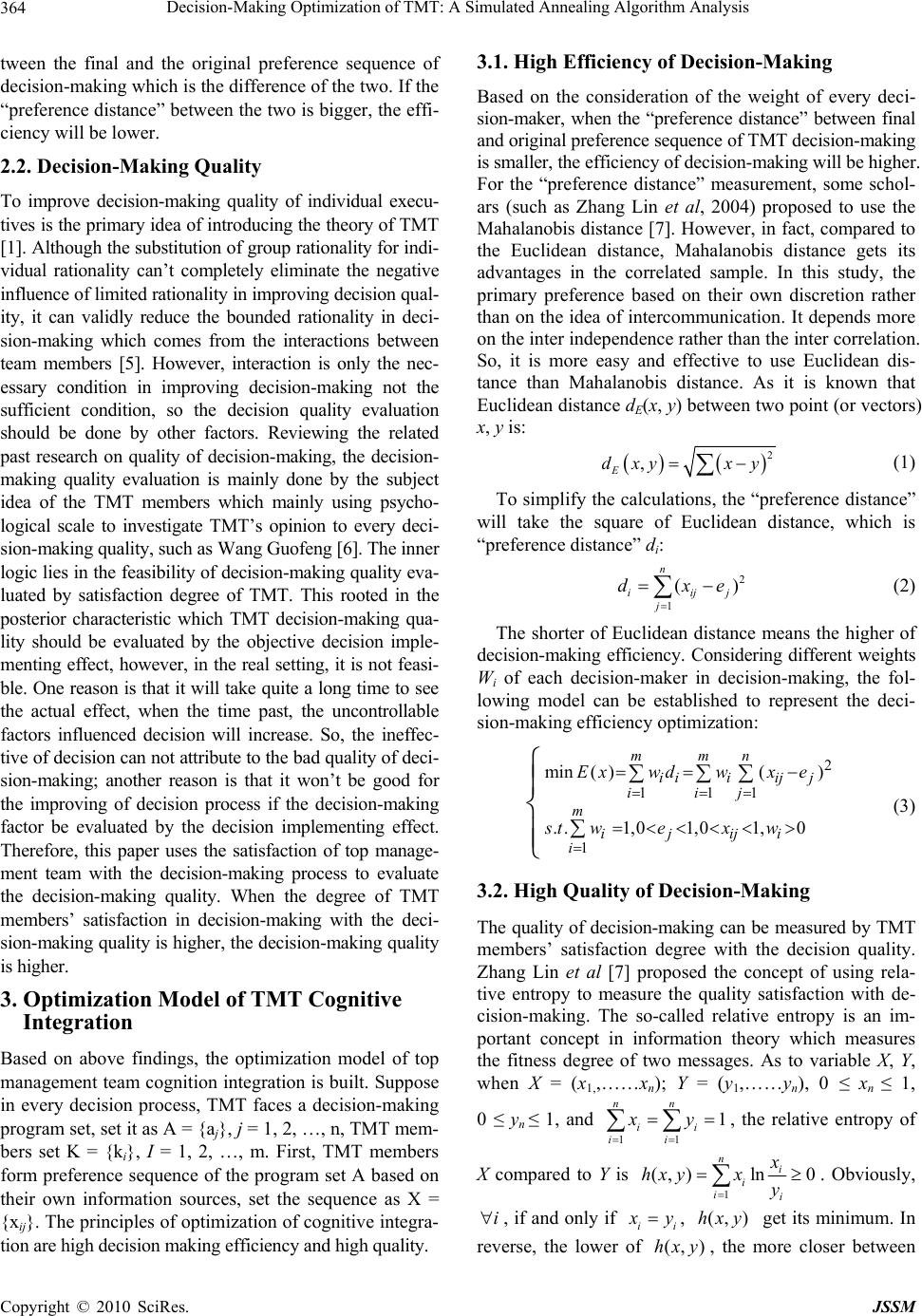 Decision-Making Optimization of TMT: A Simulated Annealing Algorithm Analysis 364 tween the final and the original preference sequence of decision-making which is the difference of the two. If the “preference distance” between the two is bigger, the effi- ciency will be lower. 2.2. Decision-Making Quality To improve decision-making quality of individual execu- tives is the primary idea of introducing the theory of TMT [1]. Although the substitution of group rationality for indi- vidual rationality can’t completely eliminate the negative influence of limited rationality in improving decision qual- ity, it can validly reduce the bounded rationality in deci- sion-making which comes from the interactions between team members [5]. However, interaction is only the nec- essary condition in improving decision-making not the sufficient condition, so the decision quality evaluation should be done by other factors. Reviewing the related past research on quality of decision-making, the decision- making quality evaluation is mainly done by the subject idea of the TMT members which mainly using psycho- logical scale to investigate TMT’s opinion to every deci- sion-making quality, such as Wang Guofeng [6]. The inner logic lies in the feasibility of decision-making quality eva- luated by satisfaction degree of TMT. This rooted in the posterior characteristic which TMT decision-making qua- lity should be evaluated by the objective decision imple- menting effect, however, in the real setting, it is not feasi- ble. One reason is that it will take quite a long time to see the actual effect, when the time past, the uncontrollable factors influenced decision will increase. So, the ineffec- tive of decision can not attribute to the bad quality of deci- sion-making; another reason is that it won’t be good for the improving of decision process if the decision-making factor be evaluated by the decision implementing effect. Therefore, this paper uses the satisfaction of top manage- ment team with the decision-making process to evaluate the decision-making quality. When the degree of TMT members’ satisfaction in decision-making with the deci- sion-making quality is higher, the decision-making quality is higher. 3. Optimization Model of TMT Cognitive Integration Based on above findings, the optimization model of top management team cognition integration is built. Suppose in every decision process, TMT faces a decision-making program set, set it as A = {aj}, j = 1, 2, …, n, TMT mem- bers set K = {ki}, I = 1, 2, …, m. First, TMT members form preference sequence of the program set A based on their own information sources, set the sequence as X = {xij}. The principles of optimization of cognitive integra- tion are high decision making efficiency and high quality. 3.1. High Efficiency of Decision-Making Based on the consideration of the weight of every deci- sion-maker, when the “preference distance” between final and original preference sequence of TMT decision-making is smaller, the efficiency of decision-making will be higher. For the “preference distance” measurement, some schol- ars (such as Zhang Lin et al, 2004) proposed to use the Mahalanobis distance [7]. However, in fact, compared to the Euclidean distance, Mahalanobis distance gets its advantages in the correlated sample. In this study, the primary preference based on their own discretion rather than on the idea of intercommunication. It depends more on the inter independence rather than the inter correlation. So, it is more easy and effective to use Euclidean dis- tance than Mahalanobis distance. As it is known that Euclidean distance dE(x, y) between two point (or vectors) x, y is: 2 , E dxy xy (1) To simplify the calculations, the “preference distance” will take the square of Euclidean distance, which is “preference distance” di: 2 1 ( n iij j dxe ) j (2) The shorter of Euclidean distance means the higher of decision-making efficiency. Considering different weights Wi of each decision-maker in decision-making, the fol- lowing model can be established to represent the deci- sion-making efficiency optimization: 2 111 1 min( )() . .1,01,01,0 mmn iiiij j iij m ijiji i Exwdwxe st wexw (3) 3.2. High Quality of Decision-Making The quality of decision-making can be measured by TMT members’ satisfaction degree with the decision quality. Zhang Lin et al [7] proposed the concept of using rela- tive entropy to measure the quality satisfaction with de- cision-making. The so-called relative entropy is an im- portant concept in information theory which measures the fitness degree of two messages. As to variable X, Y, when X = (x1,,……xn); Y = (y1,……yn), 0 ≤ x n ≤ 1, 0 ≤ yn ≤ 1, and 11 1 nn ii ii xy , the relative entropy of X compared to Y is 1 (, ) n i hxy ln 0 i i i x xy . Obviously, i , if and only if ii x y , get its minimum. In (, )hxy reverse, the lower of , the more closer between (, )hxy Copyright © 2010 SciRes. JSSM 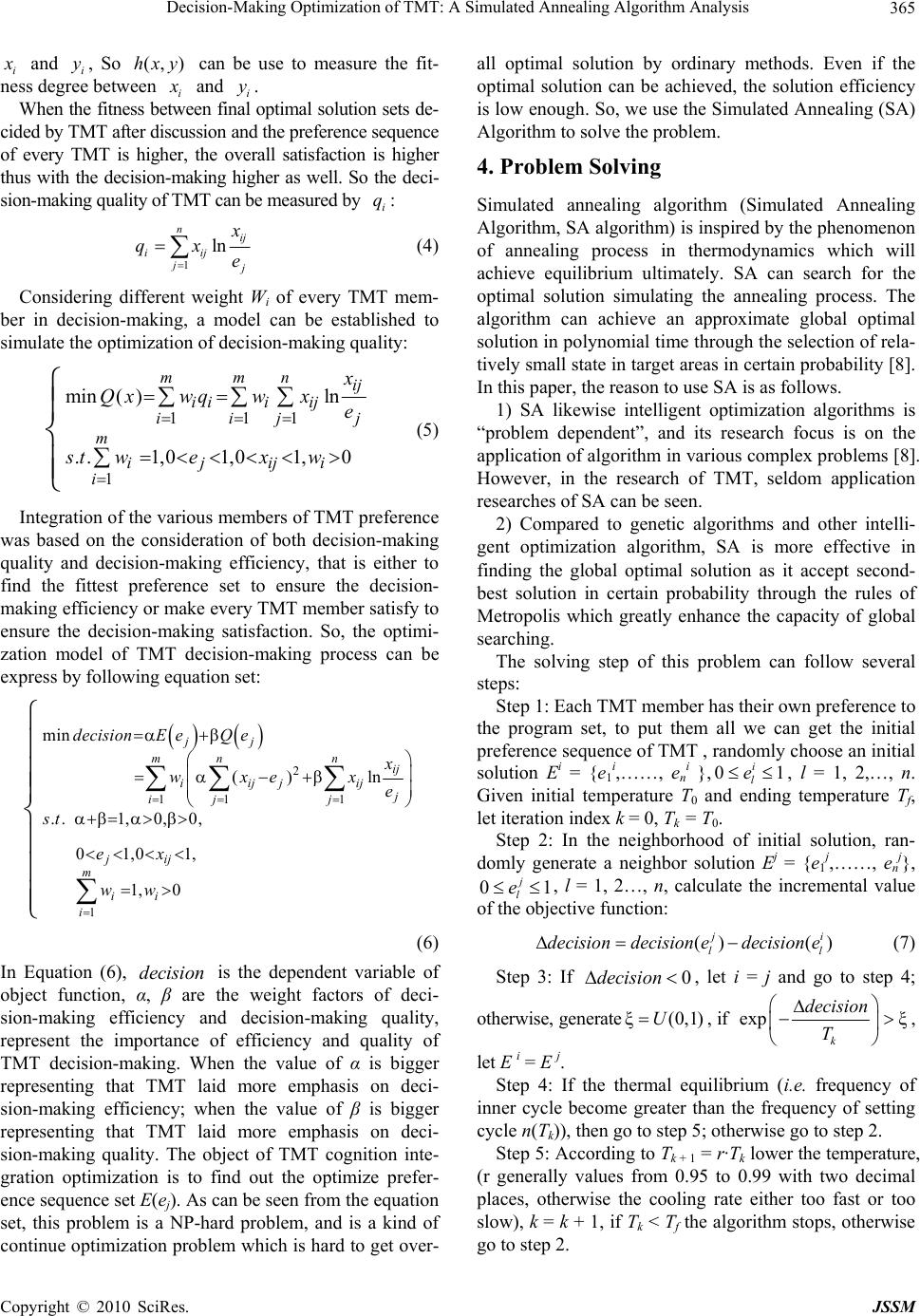 Decision-Making Optimization of TMT: A Simulated Annealing Algorithm Analysis 365 i x and i, So can be use to measure the fit- ness degree between y(, )hxy i x and . i When the fitness between final optimal solution sets de- cided by TMT after discussion and the preference sequence of every TMT is higher, the overall satisfaction is higher thus with the decision-making higher as well. So the deci- sion-making quality of TMT can be measured by : y i q 1 ln nij iij j j x qx e (4) Considering different weight Wi of every TMT mem- ber in decision-making, a model can be established to simulate the optimization of decision-making quality: 111 1 min( )ln . .1,01,01,0 mmn ij iii ij j iij m ijiji i x Qxwqw x e st wexw (5) Integration of the various members of TMT preference was based on the consideration of both decision-making quality and decision-making efficiency, that is either to find the fittest preference set to ensure the decision- making efficiency or make every TMT member satisfy to ensure the decision-making satisfaction. So, the optimi- zation model of TMT decision-making process can be express by following equation set: 2 111 1 min () ln .. 1,0, 01,0 1, 1, 0 jj mn nij iijj ij j ij j jij m ii i decisionE eQ e x wxex e st ex ww 1 1 (6) In Equation (6), is the dependent variable of object function, α, β are the weight factors of deci- sion-making efficiency and decision-making quality, represent the importance of efficiency and quality of TMT decision-making. When the value of α is bigger representing that TMT laid more emphasis on deci- sion-making efficiency; when the value of β is bigger representing that TMT laid more emphasis on deci- sion-making quality. The object of TMT cognition inte- gration optimization is to find out the optimize prefer- ence sequence set E(ej). As can be seen from the equation set, this problem is a NP-hard problem, and is a kind of continue optimization problem which is hard to get over- all optimal solution by ordinary methods. Even if the optimal solution can be achieved, the solution efficiency is low enough. So, we use the Simulated Annealing (SA) Algorithm to solve the problem. decision 4. Problem Solving Simulated annealing algorithm (Simulated Annealing Algorithm, SA algorithm) is inspired by the phenomenon of annealing process in thermodynamics which will achieve equilibrium ultimately. SA can search for the optimal solution simulating the annealing process. The algorithm can achieve an approximate global optimal solution in polynomial time through the selection of rela- tively small state in target areas in certain probability [8]. In this paper, the reason to use SA is as follows. 1) SA likewise intelligent optimization algorithms is “problem dependent”, and its research focus is on the application of algorithm in various complex problems [8]. However, in the research of TMT, seldom application researches of SA can be seen. 2) Compared to genetic algorithms and other intelli- gent optimization algorithm, SA is more effective in finding the global optimal solution as it accept second- best solution in certain probability through the rules of Metropolis which greatly enhance the capacity of global searching. The solving step of this problem can follow several steps: Step 1: Each TMT member has their own preference to the program set, to put them all we can get the initial preference sequence of TMT , randomly choose an initial solution Ei = {e1 i,……, en i },0, l = 1, 2,…, n. Given initial temperature T0 and ending temperature Tf, let iteration index k = 0, Tk = T0. i l e Step 2: In the neighborhood of initial solution, ran- domly generate a neighbor solution E j = {e1 j,……, en j}, l 0 j e , l = 1, 2…, n, calculate the incremental value of the objective function: () () j i ll decisiondecision edecisione (7) Step 3: If 0decision ξ(0,1U , let i = j and go to step 4; otherwise, generate) , if exp ξ k decision T , let E i = E j. Step 4: If the thermal equilibrium (i.e. frequency of inner cycle become greater than the frequency of setting cycle n(Tk)), then go to step 5; otherwise go to step 2. Step 5: According to Tk + 1 = r·Tk lower the temperature, (r generally values from 0.95 to 0.99 with two decimal places, otherwise the cooling rate either too fast or too slow), k = k + 1, if Tk < Tf the algorithm stops, otherwise go to step 2. Copyright © 2010 SciRes. JSSM 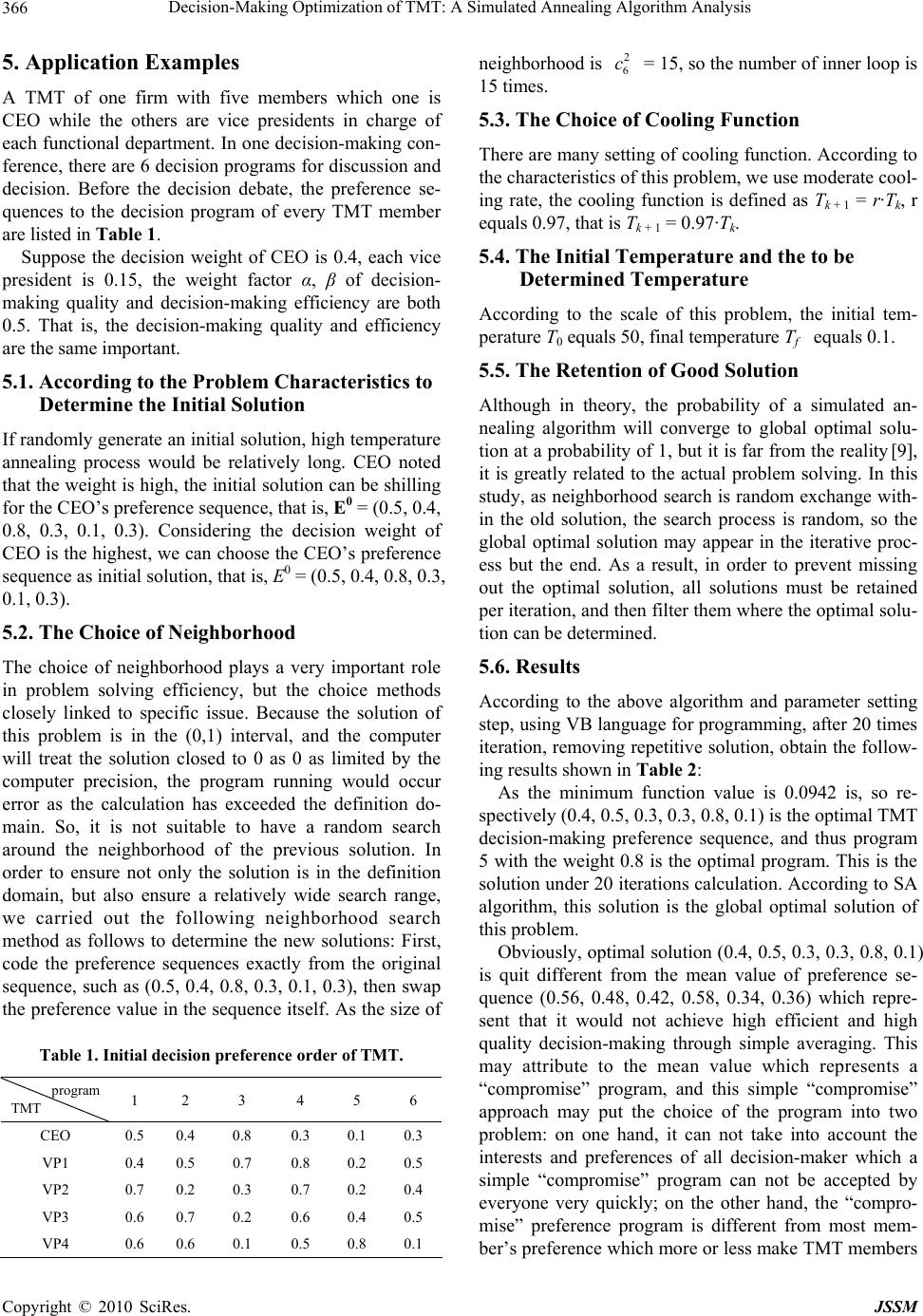 Decision-Making Optimization of TMT: A Simulated Annealing Algorithm Analysis 366 5. Application Examples A TMT of one firm with five members which one is CEO while the others are vice presidents in charge of each functional department. In one decision-making con- ference, there are 6 decision programs for discussion and decision. Before the decision debate, the preference se- quences to the decision program of every TMT member are listed in Table 1. Suppose the decision weight of CEO is 0.4, each vice president is 0.15, the weight factor α, β of decision- making quality and decision-making efficiency are both 0.5. That is, the decision-making quality and efficiency are the same important. 5.1. According to the Problem Characteristics to Determine the Initial Solution If randomly generate an initial solution, high temperature annealing process would be relatively long. CEO noted that the weight is high, the initial solution can be shilling for the CEO’s preference sequence, that is, E0 = (0.5, 0.4, 0.8, 0.3, 0.1, 0.3). Considering the decision weight of CEO is the highest, we can choose the CEO’s preference sequence as initial solution, that is, E0 = (0.5, 0.4, 0.8, 0.3, 0.1, 0.3). 5.2. The Choice of Neighborhood The choice of neighborhood plays a very important role in problem solving efficiency, but the choice methods closely linked to specific issue. Because the solution of this problem is in the (0,1) interval, and the computer will treat the solution closed to 0 as 0 as limited by the computer precision, the program running would occur error as the calculation has exceeded the definition do- main. So, it is not suitable to have a random search around the neighborhood of the previous solution. In order to ensure not only the solution is in the definition domain, but also ensure a relatively wide search range, we carried out the following neighborhood search method as follows to determine the new solutions: First, code the preference sequences exactly from the original sequence, such as (0.5, 0.4, 0.8, 0.3, 0.1, 0.3), then swap the preference value in the sequence itself. As the size of Table 1. Initial decision preference order of TMT. program TMT 1 2 3 4 5 6 CEO 0.5 0.4 0.8 0.3 0.1 0.3 VP1 0.4 0.5 0.7 0.8 0.2 0.5 VP2 0.7 0.2 0.3 0.7 0.2 0.4 VP3 0.6 0.7 0.2 0.6 0.4 0.5 VP4 0.6 0.6 0.1 0.5 0.8 0.1 neighborhood is = 15, so the number of inner loop is 15 times. 2 6 c 5.3. The Choice of Cooling Function There are many setting of cooling function. According to the characteristics of this problem, we use moderate cool- ing rate, the cooling function is defined as Tk + 1 = r·Tk, r equals 0.97, that is Tk + 1 = 0.97·Tk. 5.4. The Initial Temperature and the to be Determined Temperature According to the scale of this problem, the initial tem- perature T0 equals 50, final temperature Tf equals 0.1. 5.5. The Retention of Good Solution Although in theory, the probability of a simulated an- nealing algorithm will converge to global optimal solu- tion at a probability of 1, but it is far from the reality [9], it is greatly related to the actual problem solving. In this study, as neighborhood search is random exchange with- in the old solution, the search process is random, so the global optimal solution may appear in the iterative proc- ess but the end. As a result, in order to prevent missing out the optimal solution, all solutions must be retained per iteration, and then filter them where the optimal solu- tion can be determined. 5.6. Results According to the above algorithm and parameter setting step, using VB language for programming, after 20 times iteration, removing repetitive solution, obtain the follow- ing results shown in Table 2: As the minimum function value is 0.0942 is, so re- spectively (0.4, 0.5, 0.3, 0.3, 0.8, 0.1) is the optimal TMT decision-making preference sequence, and thus program 5 with the weight 0.8 is the optimal program. This is the solution under 20 iterations calculation. According to SA algorithm, this solution is the global optimal solution of this problem. Obviously, optimal solution (0.4, 0.5, 0.3, 0.3, 0.8, 0.1) is quit different from the mean value of preference se- quence (0.56, 0.48, 0.42, 0.58, 0.34, 0.36) which repre- sent that it would not achieve high efficient and high quality decision-making through simple averaging. This may attribute to the mean value which represents a “compromise” program, and this simple “compromise” approach may put the choice of the program into two problem: on one hand, it can not take into account the interests and preferences of all decision-maker which a simple “compromise” program can not be accepted by everyone very quickly; on the other hand, the “compro- mise” preference program is different from most mem- ber’s preference which more or less make TMT members Copyright © 2010 SciRes. JSSM 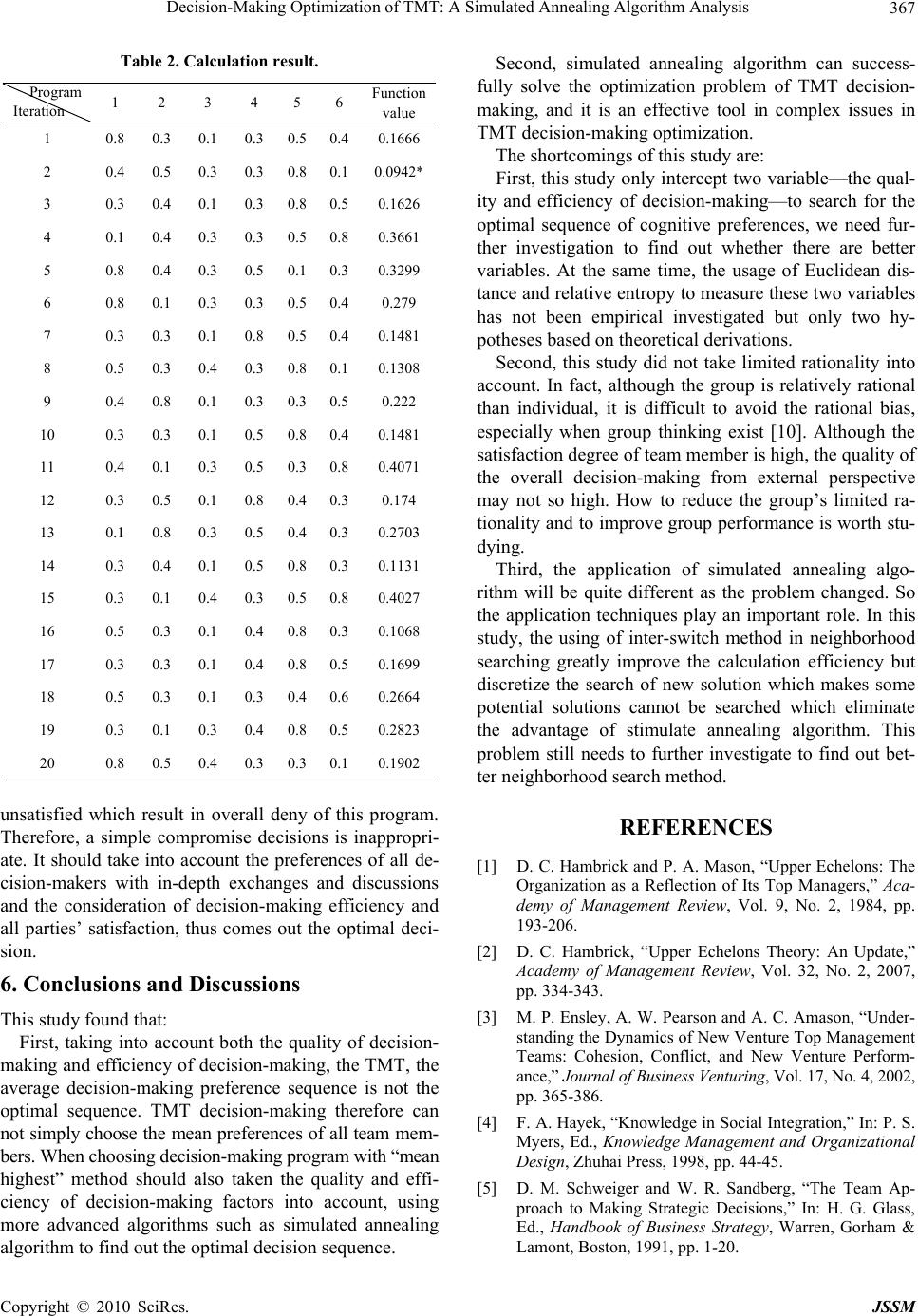 Decision-Making Optimization of TMT: A Simulated Annealing Algorithm Analysis 367 Table 2. Calculation result. Program Iteration 1 2 3 4 5 6 Function value 1 0.8 0.3 0.1 0.3 0.5 0.4 0.1666 2 0.4 0.5 0.3 0.3 0.8 0.1 0.0942* 3 0.3 0.4 0.1 0.3 0.8 0.5 0.1626 4 0.1 0.4 0.3 0.3 0.5 0.8 0.3661 5 0.8 0.4 0.3 0.5 0.1 0.3 0.3299 6 0.8 0.1 0.3 0.3 0.5 0.4 0.279 7 0.3 0.3 0.1 0.8 0.5 0.4 0.1481 8 0.5 0.3 0.4 0.3 0.8 0.1 0.1308 9 0.4 0.8 0.1 0.3 0.3 0.5 0.222 10 0.3 0.3 0.1 0.5 0.8 0.4 0.1481 11 0.4 0.1 0.3 0.5 0.3 0.8 0.4071 12 0.3 0.5 0.1 0.8 0.4 0.3 0.174 13 0.1 0.8 0.3 0.5 0.4 0.3 0.2703 14 0.3 0.4 0.1 0.5 0.8 0.3 0.1131 15 0.3 0.1 0.4 0.3 0.5 0.8 0.4027 16 0.5 0.3 0.1 0.4 0.8 0.3 0.1068 17 0.3 0.3 0.1 0.4 0.8 0.5 0.1699 18 0.5 0.3 0.1 0.3 0.4 0.6 0.2664 19 0.3 0.1 0.3 0.4 0.8 0.5 0.2823 20 0.8 0.5 0.4 0.3 0.3 0.1 0.1902 unsatisfied which result in overall deny of this program. Therefore, a simple compromise decisions is inappropri- ate. It should take into account the preferences of all de- cision-makers with in-depth exchanges and discussions and the consideration of decision-making efficiency and all parties’ satisfaction, thus comes out the optimal deci- sion. 6. Conclusions and Discussions This study found that: First, taking into account both the quality of decision- making and efficiency of decision-making, the TMT, the average decision-making preference sequence is not the optimal sequence. TMT decision-making therefore can not simply choose the mean preferences of all team mem- bers. When choosing decision-making program with “mean highest” method should also taken the quality and effi- ciency of decision-making factors into account, using more advanced algorithms such as simulated annealing algorithm to find out the optimal decision sequence. Second, simulated annealing algorithm can success- fully solve the optimization problem of TMT decision- making, and it is an effective tool in complex issues in TMT decision-making optimization. The shortcomings of this study are: First, this study only intercept two variable—the qual- ity and efficiency of decision-making—to search for the optimal sequence of cognitive preferences, we need fur- ther investigation to find out whether there are better variables. At the same time, the usage of Euclidean dis- tance and relative entropy to measure these two variables has not been empirical investigated but only two hy- potheses based on theoretical derivations. Second, this study did not take limited rationality into account. In fact, although the group is relatively rational than individual, it is difficult to avoid the rational bias, especially when group thinking exist [10]. Although the satisfaction degree of team member is high, the quality of the overall decision-making from external perspective may not so high. How to reduce the group’s limited ra- tionality and to improve group performance is worth stu- dying. Third, the application of simulated annealing algo- rithm will be quite different as the problem changed. So the application techniques play an important role. In this study, the using of inter-switch method in neighborhood searching greatly improve the calculation efficiency but discretize the search of new solution which makes some potential solutions cannot be searched which eliminate the advantage of stimulate annealing algorithm. This problem still needs to further investigate to find out bet- ter neighborhood search method. REFERENCES [1] D. C. Hambrick and P. A. Mason, “Upper Echelons: The Organization as a Reflection of Its Top Managers,” Aca- demy of Management Review, Vol. 9, No. 2, 1984, pp. 193-206. [2] D. C. Hambrick, “Upper Echelons Theory: An Update,” Academy of Management Review, Vol. 32, No. 2, 2007, pp. 334-343. [3] M. P. Ensley, A. W. Pearson and A. C. Amason, “Under- standing the Dynamics of New Venture Top Management Teams: Cohesion, Conflict, and New Venture Perform- ance,” Journal of Business Venturing, Vol. 17, No. 4, 2002, pp. 365-386. [4] F. A. Hayek, “Knowledge in Social Integration,” In: P. S. Myers, Ed., Knowledge Management and Organizational Design, Zhuhai Press, 1998, pp. 44-45. [5] D. M. Schweiger and W. R. Sandberg, “The Team Ap- proach to Making Strategic Decisions,” In: H. G. Glass, Ed., Handbook of Business Strategy, Warren, Gorham & Lamont, Boston, 1991, pp. 1-20. Copyright © 2010 SciRes. JSSM 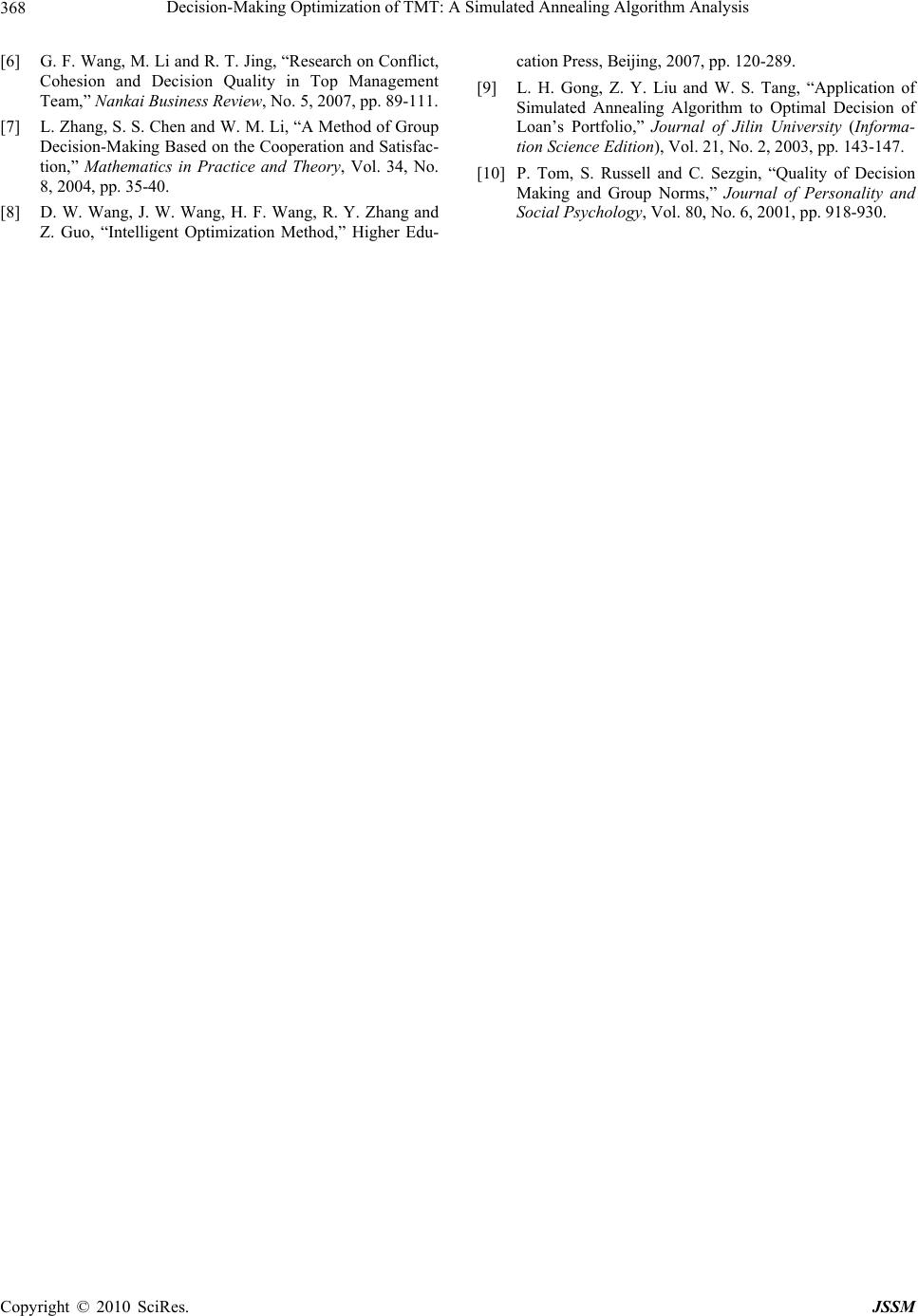 Decision-Making Optimization of TMT: A Simulated Annealing Algorithm Analysis Copyright © 2010 SciRes. JSSM 368 [6] G. F. Wang, M. Li and R. T. Jing, “Research on Conflict, Cohesion and Decision Quality in Top Management Team,” Nankai Business Review, No. 5, 2007, pp. 89-111. [7] L. Zhang, S. S. Chen and W. M. Li, “A Method of Group Decision-Making Based on the Cooperation and Satisfac- tion,” Mathematics in Practice and Theory, Vol. 34, No. 8, 2004, pp. 35-40. [8] D. W. Wang, J. W. Wang, H. F. Wang, R. Y. Zhang and Z. Guo, “Intelligent Optimization Method,” Higher Edu- cation Press, Beijing, 2007, pp. 120-289. [9] L. H. Gong, Z. Y. Liu and W. S. Tang, “Application of Simulated Annealing Algorithm to Optimal Decision of Loan’s Portfolio,” Journal of Jilin University (Informa- tion Science Edition), Vol. 21, No. 2, 2003, pp. 143-147. [10] P. Tom, S. Russell and C. Sezgin, “Quality of Decision Making and Group Norms,” Journal of Personality and Social Psychology, Vol. 80, No. 6, 2001, pp. 918-930. |

